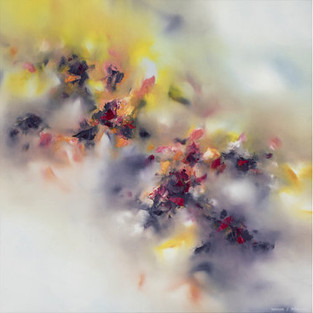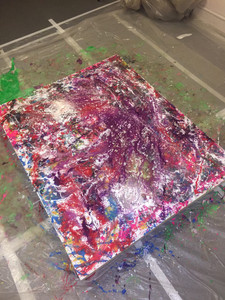Synesthesia in Art...
- amiedodgsonart
- Dec 19, 2019
- 7 min read
Following on from my recent post experimenting with marbled inks, and the inspired interest I had from my peer group regarding Synesthesia; a quick search introduced me to a couple of artists that really caught my eye and spurred on even more of an interest into it.
Synesthesia, from the Greek words syn (union) and aesthesis (sensation). According to neuroscientist and professor Richard Cytowic, however the research I have done the estimations for the prevalence of synesthesia range from 1% to 25%. Yes, this is kind of a large range. The honest answer is, that it is tricky to test for synesthesia. And is even more challenging to figure out the frequency of synesthesia. So science has not yet a clear answer to the question how common synesthesia is.“Some people are born with two or more of their senses hooked together, so that my voice is not only something that they hear—they might also see it or taste it or feel it,” Cytowic says. And what’s more, synesthetes are usually “shocked to discover that not everybody is like them.” It is believed that the female-to-male ratio is 3:1 (75%) in terms of the amount of synesthetes in the world, and they are more likely than not to be left handed.
The brain has been described as one of the most powerful and complex organisms in the universe – we are yet to even get a firm handle on what the brain is capable of, let alone begin to understand how it works. Synesthesia is just another example of how incredible and far-reaching the mind's abilities extend.
Daniel Mullen
Artist Daniel Mullen explores this fascinating sensory phenomenon with an ongoing painting series. Daniel doesn't actually have Synesthesia however he teamed up with artist, film-maker and wife, Lucy Engelman, who has this condition and visualises how she perceives time, numbers, and letters and translates that into his paintings. Mullen explains in an artist statement, “In Lucy’s case, when she sees or thinks about time and numbers she experiences a different colour sequence in her mind’s eye.” He continues, “Essentially, she has an ever changing complex and luminous filter to view the abstract concepts of our world.” Essentially time and colour is interconnected.
Each of the works contain a sequence of flat rectangular shapes arranged in a variety of arches and lines. They resemble intricate arrangements of multi-coloured glass panes. The angle of the shapes is switched in each work, some aligned with only one side facing the viewer, while others seem to project right through the canvas or retreat back into the painting’s rotated plane. It is clear to me that the meaning behind Mullen's work is really quite personal to him as it to help the viewer to see how his wife perceives the world. What a compassionate, wonderful and meaningful collaboration to do together. I find it very inspiring.
The set of paintings is called 'A Different Kind of Time: Sequencing Spatial Temporal Synesthesia.'
"Painting is a window into a reality that you can only believe because its a painting" ~ Daniel Mullen
By applying glazed layers in combination with hard-edge painted lines, Mullen creates layered images that figuratively communicate abstract concepts. When creating illusionistic forms he can, to some degree, illustrate an abstract idea or phenomenon, turning abstraction on its head. Driven by a sense that abstract art does not simply reproduce perceived outward reality but can be instead a transference of that which lies beyond our visual comprehension. It’s an artistic form -- if one follows Kandinsky's take -- that is the result of “an inner necessity”. (more about Kandinsky in another post) Mullen creates a complex affect that manages to suggest the incarnation of something grand and vast yet also perhaps just that; a suggestion and not a reality. An illusion, and not the truth. As a devoted craftsman who meticulously creates all of his work without digital or mechanical aids, he still manages to create the impression of reproducibility, which is precisely what he seeks to highlight in an era of mass consumption. His work has an architectural vibe to it which I find fascinating.
Melissa McCracken
Missouri-based artist Melissa McCracken translates the sounds she hears into vibrant splashes of colour on canvas. Her vivid oil paintings are inspired by certain songs, showcasing how she sees musical notes as different textures and hues.
“I experience the ‘wrong’ sensation to certain stimuli,” says McCracken. “Each letter and number is coloured and the days of the year circle around my body as if they had a set point in space.” The artist enjoys the many creative experiences of synesthesia, especially when it comes to music. “The most wonderful ‘brain malfunction’ of all is seeing the music I hear,” she say. “It flows in a mixture of hues, textures, and movements, shifting as if it were a vital and intentional element of each song.”
"I believe that we too often view the world through a singular and narrow lens, only allowing our habitual and empirical experiences to inform our perspective. Through my work, I hope to widen that lens, even if it at the smallest degree."
"By incorporating elements of synesthesia, I create a visualisation of music. My hope is to transcend traditional interpretations of experience and to reimagine the familiar. Intended to feel elusive, I invite the viewer to envision the potential of each piece in their own regard, thereby making the final product one of collective consciousness." ~ Melissa McCracken - Artist Statement
Her oil and acrylic paintings express snippets of the dizzyingly spectacular sights she sees and hears each day. Inspired by certain songs, the works of art burst with texture and splashes of polychromatic delight.
The images below are painted whilst listening to these songs:
Jack Coulter
Jack Coulter is a young abstract expressionist painter and photographer from Belfast, Northern Ireland. Jack also has a form of synesthesia where by the neurological phenomenon has a profound effect on his work. In an interview with The Independent, Coulter's earliest memories of his condition date back to childhood, where he recalls the sound of his own heartbeat resonating pulses of colour. Like McCracken, he also paints the colours he visualises whilst listening to songs. Here are some examples of his work.
Once of the most inspiring things, other than his synesthesia, that I found about Coulter after doing some research was in an interview with Vogue where he states "I paint with anything that I can find. I buy second-hand house paint and canvases from charity stores, and have never used a paintbrush. I find more freedom with unconventional tools such as sticks, knives and broken glass,”. I love the fact he has never used a paintbrush! He goes on to say when explaining his way of working and seeing, “The intertwining segment of tetrachromacy leaves me experiencing changing colours of actual things. Like, if I'm looking at something even without sound, my colour spectrum shifts. A leaf can turn into shimmering gold, the roses in a field can change to violet then yellow, then arrive back at red. On top of this, I have sounds resonating colours… They pulsate in front of my eyes in response to the specific sounds I hear, then still linger on my iris.” I absolutely love the way eh talks about the way he experiences colour. “Everything is automatic when music is playing and I have an empty canvas. It's fluent. My eyes, hands, arms, entire body at times just react to the composition or sound. It's such a frantic yet serene process,” he explains. “The changing colours burn in front of my eyes everywhere in response to the music, then I reach for the closest colour paint I can find that matches what I see.”
It is clear to me that music is an essential part of Coulter’s life and professional process. However in another interview with UDiscovermusic I read synaesthesia can provide people who have it with constant visual stimuli, it takes a toll living with it on a day-to-day basis. “It is over-romanticised, especially in our generation,” admits Coulter. “It’s frustrating. For me personally, I hate the fact my painterly ability can be overlooked. Take away music, my paintings remain aesthetically intact. It’s down to mastering my craft first and foremost – a neurological condition doesn’t grant you that. I’ve painted in my garage since I was 11, I’ve just turned 25. You can imagine the levels I’ve gone through psychologically. I find it hard to articulate, as I live 24/7 with audio-visual migraines that make me ill. I’m often physically sick after painting. I’ve been given medication for it, yet nothing will heal or dull the migraines. I’ve been referred to a neurologist.”
“I only paint music I feel or love”“I only paint music I feel or love” ~ Jack Coulter.
In April 2018, Coulter painted Mendelssohn's Violin Concerto live with The London Chamber Orchestra in front of an audience of 1,000 people, and streamed to over 1 million worldwide.
The artwork he produced was a literal, real-time representation of the orchestral music.
“It was surreal… Everyone kept saying to me that it looked like an… exhausting process, yet that was the only time of the whole evening I felt truly at home.” ~ Jack Coulter.
Dazed summed it up quite nicely for me, 'at a time when both artist and consumer remain enamoured by the perception of the artist as an entity, it feels his work is a little out-of-step with the art world’s current climate. Not some ego-fuelled, half-academic attempt to comment on society at large, but as a sensual process to explore, channel and soothe a condition characterised by extreme emotional reactions to the everyday, as well a mechanism for coping with a world blasted in neon and shimmering like the first heavy wave of a mescaline trip.'
To Summarise
The aspects of all of these artists work that I find most intriguing is that they are combining colour and painting with music, emotions or time. Combining the senses to create art is a wonderful thing. I find it all incredibly fascinating and something I would love to explore myself and see what results I can come up with. Looking into this has led me to explore the use of art and music and combining both. How can I create art directly from music myself? How can I paint with music? These are questions I will be asking myself in my next project.






































































































Comments